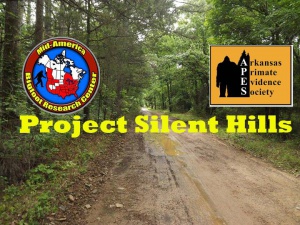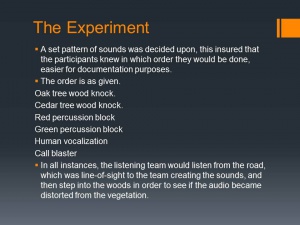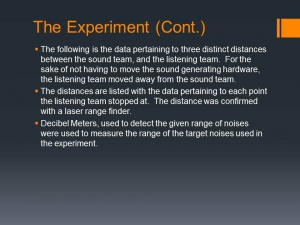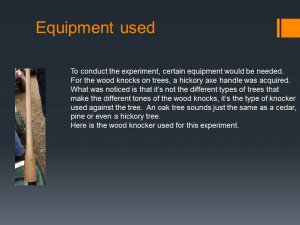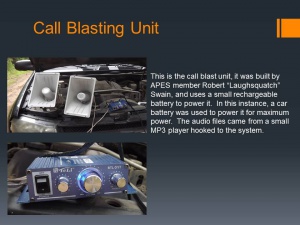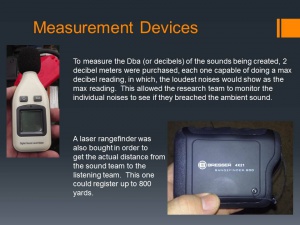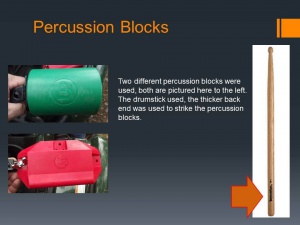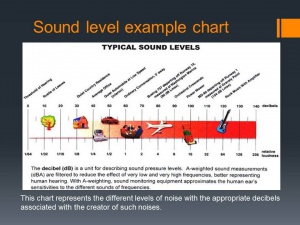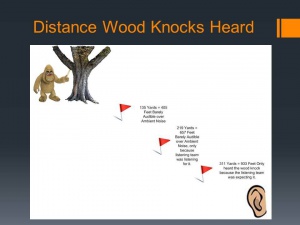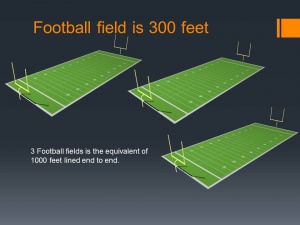Difference between revisions of "(Protocols) Project Silent Hills"
m (Darkwing moved page Project Silent Hills to (Protocols) Project Silent Hills without leaving a redirect) |
|
(No difference)
| |
Latest revision as of 15:00, 8 September 2022
Project Silent Hills began when two MABRC Senior Field Researchers Randy "Rebelistic" Savig and Bernie "Old hippy" Wall began a short test with wood knocks to see if they could hear them at what distance. Telling the MABRC Executive Director D.W. "Darkwing" Lee about their results, plans were put into place in order to do it in a scientific manner. With cooperation from the Arkansas Primate Evidence Society (APES), the experiments were called Project Silent Hills and would be done in three phases. The results showed quite clearly that wood knocks and vocalizations decreased significantly within a short range. It decreased even more when the temperature was low. You can see the data from all three phases below along with the powerpoint slides for the first phase.
Phase 1 - Silent Hills Project
Participants
From the Mid-America Bigfoot Research Center:
- D.W. “Darkwing” Lee
- Izzy “Goose” Gutierrez
- Mike “CompresserMike” Hartsell
- Dave “Squatchfinder” Ganote
- Randy “Rebelistic” Savig
- Mark “Sawdustt” Newbill (Also an APES member)
From the Arkansas Primates Evidence Society
- Robert “Laughsquatch” Swain
Baseline of sounds used
After locating the area that the experiment would be held at, the team needed to obtain the baseline readings for each sound. Holding the Decibel meter at average of 3 feet from each sound being created, 3 times each sound was measured to obtain the base (average) reading of the sound level that was used. The levels are listed below with their average decibel level. The call blast unit was not measured for an average as it was going to be the same level due to the sound settings.
Using wood handle made of Hickory:
- Cedar Tree: 92.5, 93.7, 94.1 Average 93.4 Dba
- Oak Tree: 97, 96.4, 95.8 Average 96.4 Dba
Using snare drumstick, the thicker end.
- Red percussion block: 110.8, 110.1, 120.6 Average 113.8 Dba
- Green percussion block: 117.3, 118.1, 118.6 Average 118 Dba
Using the call blast unit, we measured according to the volume control on the unit.
Call Blast unit – Ohio Howl
- Setting 5: 114.7 Dba
- Setting 10: 122.4 Dba
- Setting 15: 127.8 Dba
- Setting 20: 130.9 Dba
Mike “Compressermike” Hartsell and Randy “Rebelistic” Savig both did vocalizations, an average was done for both.
- Mike's Whoop: 113.6, 109.9, 112.3 Average 111.9 Dba
- Randy's Whoop: 107.5, 108.4, 107.1 Average 107.7 Dba
135 yards = 405 feet
- Ambient noise 46.6 Dba
- Cedar No register
- Oak No register
- Red Percussion block 75 72.7 74.1 Dba
- Green Percussion block 72.3 69.2 Dba third done in trees nothing registers
- Call blast 79.7 78.8 Dba
- Whoop 65.1 69.0 Dba
219 yards = 657 feet
- Ambient noise level 46.5 Dba
- Cedar No register
- Oak No register
- Ambient Noise level 69.1 Dba
- Red Percussion block 72.6 Dba
- From woods 58.5 Dba
- Ambient noise level 62.8 Dba
- Green Percussion block 68.2 Dba
- Call blast 67.7 Dba
- From woods 60.2 Dba
- Ambient Noise level 59.8 Dba
- Whoop 63.4 Dba
- Woods No register
311 yards = 933 feet
- Ambient noise level 50.1 Dba
- Cedar Wood Knock None
- Ambient noise level 45.5 Dba
- Oak Wood Knock None
- Ambient Noise 65.7 Dba
- Red percussion block 67.3 Dba
- From woods 61 Dba ambient noise
- Ambient Noise level 63 Dba
- Green percussion block 66.3 Dba
- From woods 53.4 Dba ambient noise
- Call Blast 66.4 Dba
- Call Blast from woods 64.1
- Ambient noise level 59.3 Dba
- Whoop 61.3 Dba
- From woods ambient noise level 53.2 Dba
Conclusion
The data clearly shows that the wood knocks occur closer than most researchers have originally believed. If you hear a loud wood knock, it’s within 200 feet or less from you. If you can hear the wood knock at all, its within 1,000 feet of your position. The use of the percussion blocks have produced sounds that have been heard at greater distances, but from comments made from the base camp, nearly a mile away from the test site, the knocks caused by the blocks sounded like plastic being used to produce the knocks. The vocalization used by the call blaster was the Ohio Howl, and was clearly heard up to a mile away by the base camp, this shows that the vocalization does carry further, and further research needs to be done on this part of the experiment.
PHASE 2 - Silent Hills Project
I still have to add it to the other information, but here is the data for what we call Phase 2 of the project, how cold weather affects the decibel readings. I have to say this first off, on Friday night about 7 PM, we heard a vocalization off in the distance, it was clear but what we thought was at a distance of a half mile or more from the camp. Date: Jan. 16, 2016 Location: Malfunction Junction (Natural Dam, Arkansas) Temperature: 38 degrees F.
Participants:
- CompresserMike,
- Squatchfinder,
- Sawdustt,
- Cherokee Rose,
- Darkwing
Base Readings
Ambient 24 23 23 Cedar 66 68 69 Oak 65 63 55 Green Block 79 68 63 Call Blast 92 89 93 (Device set for 14 on the volume control) Vocalization 90 89 86.5
135 Yards
- Ambient 23 24 23
- Cedar 34 37 33
- Cedar in woods 36 33 35
- Oak 34 33 32
- Oak in woods 32 29 30
- Green Block 53 47 46
- Green Block in woods 30 37 38
- Call Blast 50 52 49
- Call Blast in woods 50 50 47.5
- Vocalization 54 53 55
219 Yards
- Ambient 26 27 26
- Cedar 0 0 27
- Cedar in woods 0 0 0
- Oak 0 0 0
- Oak in woods 0 0 0
- Green Block 35 34 36.5
- Green Block in woods 30 29 28
- Call Blast 32 32 38
- Vocalization 35 31 30
0 means that it did not clear over the ambient noise levels, the only reason the listening team heard the knocks was because they anticipated them and was listening intently for them.
311 Yards
- Ambient 23 22 22
- Cedar 0 0 0
- Cedar in woods 0 0 0
- Oak 0 0 0
- Oak in woods 0 0 0
- Green Block 26 0 24
- Call blasting 27 24 23
- Vocalizations 25 24 0
0 means that it did not clear over the ambient noise levels, the only reason the listening team heard the knocks was because they anticipated them and was listening intently for them.
On the Memorial Day expedition, the call blasting was heard at Base Camp during the experiment. Road distance is 7/10 miles, while by direct distance it's 6/10 miles.
To test the distance it could be heard during colder weather, Cherokee Rose and Darkwing returned to Base Camp and listened for several minutes before Darkwing started traveling back towards the experiment Base site. At the 3/10 mile mark, Darkwing was finally able to hear the call blasting. From what was observed from the experiment in Phase 2, the cold adversely affects the distance that the wood knocks and vocalizations can travel. Leading the field team to deduce that the vocalization heard the night before was even closer than originally thought. The cold actually halved the distance on all knocks and vocals.
Phase 3 will now be planned out, in it, we will be seeing what the distance decibel ranges are using parabolics and recorders of various types and makes. To see the difference in each according to sound.
Phase 3 - Utilizing parabolics and recorders to see how the sound is affected at the distances.
Below is the readings taken with the decibel reader. We are still evaluating the audio recorded by the parabolics and will post that soon.
Project Silent Hills Date and time: May 28, 2016 Temp: 79 degrees F Humidity: 63%
Participants:
- Darkwing
- Cherokee Rose
- Rebelistic
- Squatchfinder
- CompresserMike
- Sawdustt
- Splatter
- Deer Slayer
- Superdave
- Laughsquatch
- Jamie
- Lexis
Base Settings
- Oak 95.6 97.2 103.5
- Cedar 107.4 107.6 107.7
- Green Block 107 111.9 110.5
- Mike 114.8 114.3 116
- Randy 111.7 114.5 117.8
- Call Blast 115.4 116.6 112.4
135 yards
- Oak 43.7 54.2 60.6
- Cedar 61.7 58.8 56.7
- Green Block 68.6 52.5 70.8
- Mike 69 63.2 63.1
- Randy 65.9 64.9 65.9
- Call Blaster 64.1 66.3 62.7
229 yards
- Oak 48.5 50.4 46.2
- Cedar 47 45.8 48.1
- Green Block 65.9 62.9 64.7
- Mike 61.6 59.7 56.3
- Randy 62.4 63.7 61.3
- Call Blaster 56.5 54.8 59.1
411 Yards
- Oak 43.8 43.6 45.1
- Cedar 42.7 0 43.4
- Green Block 52.7 56.1 56.3
- Mike 56.2 55.6 55.7
- Randy 65.9 55 58.3
- Call Blast 46.7 50.3 55.5
Participants Comments
Randy “Rebelistic” Savig
Needless to say this was a very eye opening experience. None of the luster was lost from when Bernie and I did it back in February. At that time there was no leaves on the trees and there was no wind. So the noise travel was further than during the experiment at the expedition. This whole thing started with us after we had a complete dead night in the woods. I had a remote recorder set up about a mile from camp. At the end of the night I did a couple of howls and knocked 3 times on three different trees to be able to hear the different sounds the trees would make. When doing the audio review the howls came out loud and clear, but even turning up the gain the knocks were not heard.
One thing that was really interesting to me is that the tones of the knocks doesn't change when different trees are used. Only the volume changes. My conclusion to that is that the knocker us what is setting the tone.
For me it begs the question on to whether these critters are actually knocking wood with wood or if another mechanics is being used. There has been some reports of Bigfoots seem with sticks or clubs but they are limited. With the leaf litter and ambient noises of the typical summer night I suspect that they are a lot closer then even our numbers that were collected during the experiment.
One other thing I would like to see is that other groups try this experiment as for me my ears tell me a lot more than the numbers do. I think if they would experience this type of things it will have as huge of an impact on them as it did me. We never did try this experiment with rock clacking but I know it would have similar results. Folks if you hear knocks or clacks, you'd better pay attention as they could literally be feet away. I also would like to see this type of thing done during each expedition as it would give the researchers a baseline to consider these types of vocalizations during the seasons of the year and terrain as each will be unique. We may also want to do a perimeter walk around camp to get a baseline for bipedal foot steps if they would occur around camp during the expedition.
Mark “Sawdustt” Newbill
Since coming home from camp and reflecting on the deception of what I thought the results of the experiment results would be and how it is obvious the experiment needs to be done again with different variables (seasons, weather, regions and so on) I keep going back to that tree falling where Mike, Robert and Izzy went to experience the sounds for themselves. It's odd to me that the others didn't even hear the tree fall. Is it a coincidence that the tree fell that close to them when the vocal blast was that of a believed wounded Bigfoot or the next day another tree fell in the same location but across the road?
What if the next time the Project Silent Hill Experiment is being conducted we could use members for surveillance with whatever tools we have at our disposal?
Examples-Trail cameras or members hidden on adjacent roads to see if we were drawing a creature in. Someone monitoring the area with parabolics or setting out recorders prior to the experiment. A drone in the sky monitoring a larger area.
I just hope I'm at the next Project Silent Hill
Robert “Laughsquatch” Swain
APES members were very excited and honored to be a part of such a ground breaking experiment. Knowing the limits of our field research does not limit us but opens doors of opportunity and understanding. I was amazed at how limited the level of audio sounds are in the forest. It is evident by this experiment that the sounds that we hear and record are much, much closer to our ears and recorders than previously thought. That is exciting and unsettling at the same time!
I would like to have extended the experiment farther than 311 yards. Especially since some of the sounds were actually heard at base camp one quarter mile away. Perhaps the distance should be extended until the sounds cannot be heard.
I was glad that I had the opportunity to contribute my call blast equipment to the experiment. I have several calls recorded on my MP3 player. The first call in the list is the Ohio Howl which is a 1970’s recording of a supposedly wounded creature calling out from a gravel quarry. It really does sound like a wounded animal in a creepy way. We repeatedly played this call several times (eleven times if I counted correctly) simply because it was first in line. I believe that by using this call that we may have called in a concerned creature to our location. When Mike, Izzy and myself were at the 933 feet location when we heard a large, heavy tree crash down right within the tree line (possibly 50 ft.). It was a very odd coincidence for a tree to fall that close to us during the experiment. But to find a second tree fallen in the road the next morning at the same location should give one pause to think that this was not a random act. The next night (Sunday night) we all heard a third tree fall during the middle of the night. Three trees within a 30 hour window within a quarter mile area is very uncanny!
Another thought is that if the experiment did bring in a Bigfoot, the creature must have been very close to us to hear the wood knocks, audio calls and call blast. Perhaps it was watching us conduct the experiment. I also wondered if it was a coincidence that since I was the one operating the call blast of the wounded creature that the tree crashed down where I was at.
A few things that I think need to happen are the experiment needs to be repeated multiple times. Different seasons, different weather conditions i.e. wind, rain, snow (falling and on the ground), day and night. Also, rock clacks should be added to the list of sounds. I also think that an experiment using bionic ear and parabolic mics verses the naked year. In that same vein, it would be interesting to test the digital recorders we use verses our naked ears. Although I see no scientific way to measure this, it would also be interesting to see how different sounds are picked up by young ears verses old guys like us. What are we not hearing?!
Please know that APES will participate in any further experiments and expeditions of this caliber!
Robert Swain
